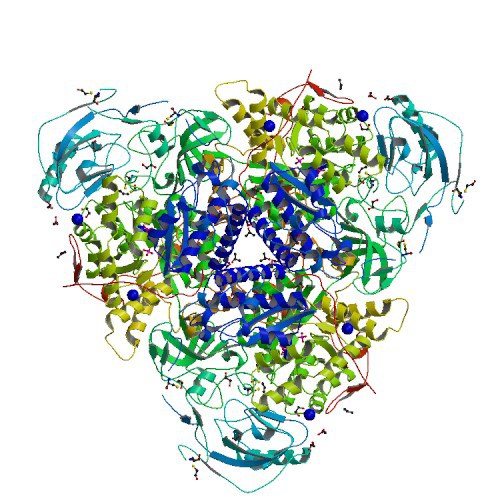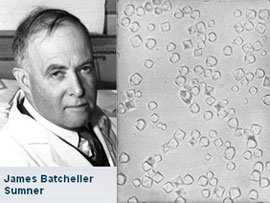Crystallising enzymes from beans – celebrating Sumner
What does it look like?

4GY7 jack bean urease deposited in the PDB in 2012. From the paper Crystallographic structure analysis of urease from Jack bean (Canavalia ensiformis) at 1.49 Å resolution deposited by Begum, A., Banumathi, S., Choudhary, M. I. & Betzel, C.
What is it and where did the structure come from?
This urease, extracted from a jack bean, was the first enzyme ever to be crystallised, meaning that the arrangement of atoms that make it up could then be studied and understood. The man that achieved this, Jame Batcheller Sumner, was later to win a Nobel Prize in 1946 for this achievement. Sumner, whose birthday it would be today, actually achieved this feat in 1926 – but it took a number of years to convince the sceptical scientific community that he had isolated an enzyme in his crystals .

James Sumner and his first crystals of an enzyme.
The Nobel Prize in Chemistry 1946 was divided, one half awarded to James Batcheller Sumner "for his discovery that enzymes can be crystallized", the other half jointly to John Howard Northrop and Wendell Meredith Stanley "for their preparation of enzymes and virus proteins in a pure form".
Sumner's biography on the Nobel Prize website gives a great insight into how this achievement gradually gained acceptance:
"Gradually, recognition came. In 1937, he was given a Guggenheim Fellowship; he went to Uppsala and worked in the laboratory of Professor The Svedberg for five months. He was awarded the Scheele Medal in Stockholm in the same year. When Northrop, of the Rockefeller Institute, obtained crystalline pepsin, and subsequently other enzymes, it became clear that Sumner had devised a general crystallization method for enzymes. The opponents gradually admitted Sumner's and Northrop's claims – Willstätter last of all – and the crowning recognition came in 1946 when the Nobel Prize was awarded to Sumner and Northrop. In 1948, Sumner was elected to the National Academy of Sciences (USA)."
In Sumner's Nobel acceptance lecture he said: "Why was it difficult to isolate an enzyme? … i.e. in pure condition. It does not seem difficult to isolate and crystallize an enzyme now, but it was difficult 20 years ago. ... When I succeeded I then telephoned to my wife 'I have crystallized the first enzyme'."
Tomorrow we'll have a post about the urease structure in detail, and why it took 85 years from when Sumner first grew the crystals to determining the structure.
References
James B. Sumner. The chemical nature of enzymes. Nobel Lecture, December 12, 1946
"James B. Sumner – Biographical". Nobelprize.org. Nobel Media AB 2014. Web. 13 Nov 2014. http://www.nobelprize.org/nobel_prizes/chemistry/laureates/1946/sumner-bio.html
See also:
P. A. Karplus, M. A. Pearson and R. P. Hausinger. 70 Years of Crystaline Urease: What Have We Learned? Acc. Chem. Res. (1997), 30, 330-337.
N. E. Chayen, J. R. Helliwell and E. H. Snell. Macromolecular Crystallization and Crystal Perfection. (Oxford University Press/International Union of Crystallography Monographs on Crystallography, 2010).






